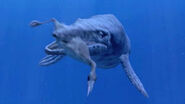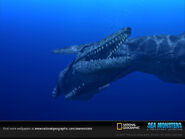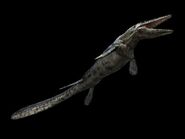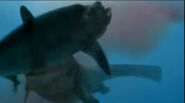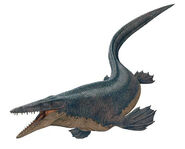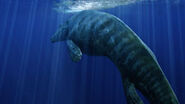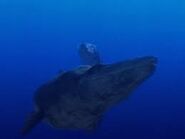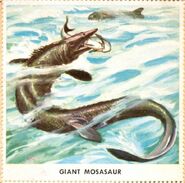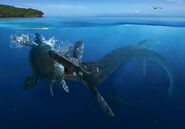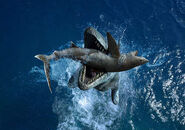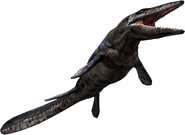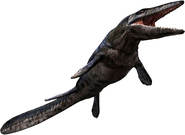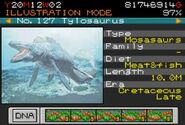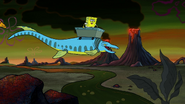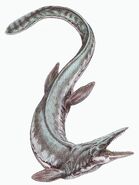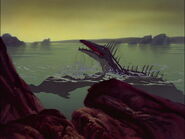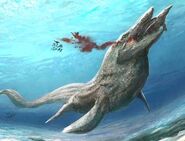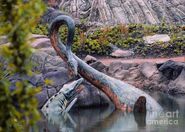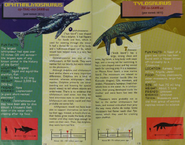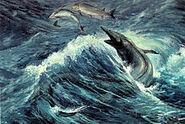| Tylosaurus Temporal range: Late Cretaceous | |
|---|---|

| |
| An artist's illustration of Tylosaurus proriger | |
| Scientific classification | |
| Domain: | Eukaryota |
| Kingdom: | Animalia |
| Phylum: | Chordata |
| Class: | Sauropsida |
| Family: | †Mosasauridae |
| Subfamily: | †Tylosaurinae |
| Genus: | †Tylosaurus Marsh, 1872 |
| Type species | |
| †Tylosaurus proriger Cope, 1869 | |
| Referred Species | |
| |
| Synonyms | |
| |
Tylosaurus is an extinct genus of tylosaurine mosasaur from the Late Cretaceous seas. The animal has been found across several ancient oceans and contains 7 distinct species. The type species of the genus is T. proriger.
Description[]
Like other mosasaurs, Tylosaurus had a long streamlined body with four large flippers, and a fluked tail resembling that of an upside down shark's. Evidence for tail flukes on mosasaurs comes from the related genus Prognathodon, showing that mosasaurs used their tails for strong propulsion much like ichthyosaurs and sharks did, while the rest of their bodies remained with slight movements, thus indicating a (sub-)carangiform swimming style. This contrasts with the earlier eel-like depiction of Tylosaurus undulating its body side to side while swimming.
Microscopic analysis of Tylosaurus scales detected traces of the pigment eumelanin, showing that this mosasaur had a dark coloration similar to the leatherback sea turtle. This may have been complemented by countershading, in which the underside of Tylosaurus was light in color, allowing it to remain difficult to detect in the oceans as it ambushed prey.
Discovery and naming[]
Tylosaurus was the third new genus of mosasaur to be described from North America, the first two being Clidastes and Platecarpus. The type specimen was described by Edward Drinker Cope in 1869 based on a fragmentary skull measuring about 5 feet (1.5 m) in length and thirteen vertebrae. The remains were recovered from a deposit of the Niobrara Formation in Kansas, which was once a part of the Western Interior Seaway during the Cretaceous. Cope's first publication of the fossil named it Macrosaurus proriger, although the name was already occupied by a European mosasaur taxon. The species name proriger means "prow-bearing", in reference to the specimen's unique prow-like elongated rostrum. In 1870, Cope moved the specimen into another European genus Liodon, and Othniel Charles Marsh later assigned it to a new genus Rhinosaurus (meaning "nose lizard") in 1872. The genus name Rhamphosaurus was then brought up by Cope in case Marsh was correct about Liodon proriger being taxonomically distinct from the European genus. However, Rhamphosaurus was already in use for a genus of lizard, and the name was finally changed to Tylosaurus (meaning "knob lizard" due to the genus's elongated rostrum).
Classification[]
Tylosaurus is classified within the family Mosasauridae in the superfamily Mosasauroidea, belonging to subfamily Tylosaurinae. Tylosaurinae is defined by a shared feature of an elongated premaxillary rostrum that does not bear teeth, and it includes other mosasaurs such as Taniwhasaurus and Kaikaifilu.
The oldest fossil attributable to Tylosaurus is a premaxilla recovered from Turonian deposits in Texas, which is dated between 92.1 and 91.4 million years old. A tooth from a Late Maastrichtian deposit in Poland dating close to the K-PG boundary has been attributed to Hainosaurus, but since Hainosaurus is now considered a synonym of Tylosaurus, this also makes the genus one of the last mosasaurs. Currently, there are eight valid species of Tylosaurus: T. proriger, T. nepaeolicus, T. bernardi, T. gaudryi, T. ivoensis, T. iembeensis, T. pembinensis, and T. saskatchewanensis. There is still debate whether T. kansasensis is a synonym of T. nepaeolicus, and T. borealis has not yet been described in a formal publication.
Paleobiology[]
Tylosaurus was most likely an ambush predator, and the apex predator of its ecosystem. It was not very heavy for a marine animal of its length and had a reduced body density, helping it to rapidly accelerate during an attack, assisted with the long and powerful tail of the mosasaur.
Tylosaurus exploited the wide variety of marine fauna in its ecosystem. Stomach contents are well documented, including other mosasaurs, plesiosaurs, turtles, birds, bony fish, and sharks. Additional evidence from bite marks suggests the animal also preyed on giant squid and ammonites. A single Tylosaurus skeleton from the Pierre Shale of South Dakota had the remains of a 2-meter long mosasaur, the diving bird Hesperornis, a Bananogmius fish, and possibly a shark all within its stomach. Other records of stomach contents show that Tylosaurus preyed upon the plesiosaur Dolichorhynchops, the fish Cimolichthys, the small mosasaurs Clidastes, Platecarpus and Plioplatecarpus, the giant turtle Protostega, ammonites, and large squid.
The behavior of Tylosaurus towards each other may have been mostly aggressive due to fossil evidence, and at least one fatal instance of combat between Tylosaurus individuals is documented in the T. kansasensis holotype, which represents an animal about 5 meters long (16 ft). The specimen possesses numerous injuries that indicate it was killed by a larger Tylosaurus. Due to modern-day male lizards employing head-biting in territorial battles for dominance, it is very plausible that Tylosaurus behaved in similar ways.
Size[]

Tylosaurus is one of the largest, if not the largest known mosasaur ever discovered. The largest well-known specimen, a skeleton of T. proriger nicknamed "Bunker" has been estimated to measure around 14 meters long (46 feet long) and around 9 - 11 tonnes in weight. The skull itself was estimated at around 1.7 meters long and would have accounted for about 13 - 14% of the animal's total length. Other specimens such as "Bonker" (FHSM VP-2496) or MDM M83.13.18 probably even surpassed Bunker in size but requires further analysis.
By the Santonian Stage of the Late Cretaceous, T. napaeolicus and T. proriger were about 8-9 meters (26-30 feet long) in length and weighed around 1 - 3 tonnes, the latter of which reached larger sizes of 13-14 meters long (43-46 feet) by the Campanian Stage. It has been speculated that older Tylosaurus could grow to even larger maximum sizes as mosasaurs continuously grew through their lifetime, but due to lack of fossil evidence it remains to be seen. The largest Tylosaurus specimen on display, as well as the largest mosasaur skeleton on display, is known as "Bruce", which measures at 13.05 meters long (42.8 feet long). The mount of Bruce is probably oversized due to published measurements seen in papers do not indicate such size.
In Popular Culture[]
- A Tylosaurus appears in Jurassic Park: The Game where it consumes Dr Laura Sorkins and attempt to eat the rest of the survivors. The cloned Tylosaurus had a row spikes running down its neck to its upper back like outdated depictions of mosasaurs from the late 1800s. It also lacked a tail fluke, with another row of spikes covering the tail. The clone's skull was unlike Tylosaurus being as short as the mosasaur Platecarpus with the jaws not being completely straight. The skin color of the cloned Tylosaurus was a shade of blue with black striping and a yellowish white underbelly. It was originally the unnamed marine reptile in the game being only referred to as "Mosasaur". In Laura Sorkin's research journal, she describes the creature and labels it "Mosasaur". She also writes: "Upwards of 50 feet long, depending on genus." From this text it is clear that she doesn't know its genus, indicating that she calls the creature "Mosasaur", she refers to the family to which it belongs; which is Mosasaurs (Mosasauridae). The identity of Jurassic Park's Mosasaur was ultimately revealed to be Tylosaurus in the InGen Field Guide.

- Tylosaurus is number 127 of the Carnivore Threes that can be created in Jurassic Park III: Park Builder. As a carnivore, it should be placed in its own enclosure, considering that if it gets placed with another animal, it will kill it. In-game it looks like a plesiosaur, probably because the game makers didn't have large enough a budget to make its own model.
- Tylosaurus appears in the underwater park update for the game Jurassic Park: Builder.
- 2 Tylosauruses appear in The Dino King when Speckles and One-Eye battle each other in the sea. One of the two eventually grabs One-Eye by the neck after being greviously injured by Speckles Sr. who tried to save his son. The two Tylosauruses then take him to the deeper sea.
- Tylosaurus appears in the underwater section for the game Jurassic World: The Game as a VIP surface creature in the solid gold pack.
- It appears in National Geographic's Sea Monsters: A Prehistoric Adventure as well as the game spinoff as the top predator.
- It was the giant mosasaur in BBC's Chased by Sea Monsters, hunting Nigel Marven and his crew, thinking they were an Archelon.
- It was seen as the giant mosasaur in Discovery Channel's Monsters Resurrected "T-rex of the Deep".
- It appears in The Rite Of Spring in Fantasia where several Tylosaurs appear swimming in the coastal ocean in a group, surfacing to gasp for air. Late on in the scene, one of these top predators of the sea catches a Pteranodon by the head as it skims the water's surface, fishing for squid and fish. The Tylosaurus depicted in Fantasia had spikes on its neck and back region, features that the real animal did not sport. However, this makes sense for the time as the scientists who discovered the Tylosaurus first thought that it had spines down its back, but it was discovered later on that it had a smooth back.
- Tylosaurus was also in the Evolution's Winners the 1st episode of Dinosaur Revolution.
- Tylosaurus appears in the popular television series SpongeBob SquarePants during episode ”Lost and Found.”
- Tylosaurus was originally gonna appear in Dinosaur, but it never made it to the final cut. Although, there is a design of the creature for the film.

